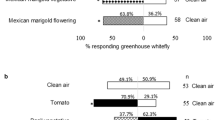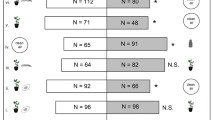Abstract
Experiments were conducted to determine ifDrosophila melanogaster Meig. was differentially attracted to decaying potato tissue infected withErwinia carotovora var.carotovora as compared toE. C. var.atroseptica because these insects transmit each bacterium at a different rate in nature. The results of olfactometer tests demonstrated that potato tissue infected with the two varieties of the organism do not differ in their attractiveness toD. melanogaster; also, that attraction of these flies to healthy potato tissue was not significantly different than the attraction to infected tissue.
Resumen
Se condujeron experimentos para determinar siDrosophila melanogaster Meig. es atraída diferencialmente a tejidos de papa infectados conErwinia carotovora var.carotovora en comparación conE.C. var.atroseptica ya que estos insectos tienen distintas tasas de transmissión para cada una de estas bacterias en la naturaleza. Pruebas de olfatómetro demonstraron que tejido de papa infectado con cada una de las dos variedades del microorganismo no se diferenciaron en su atractividad aD. melanogaster; ademas, la atractividad de tejido sano de papa no fue significativamente distinto al de tejido infectado.
Similar content being viewed by others
Literature Cited
DeBoer, S.H. and A. Kelman. 1975. Evaluation of procedures for detection of pectolyticErwinia spp. on potato tubers. Am Potato J 52: 117–125.
Fonk, W.D. and J.A. Kamm. 1964. Olfactory response of the alfalfa-seed chalcid,Bruchophagous roddi Guss. to chemicals found in alfalfa. Univ of Wyo Agric Exp Stn Bull 413.
Harrison, M.D., C.E. Quinn, I. Ann Sells, and D.C. Graham. 1977. Waste potato dumps as sources of insects contaminated with soft rot coliform bacteria in relation to re-contamination of pathogen-free potato stocks. Potato Res. 20: 37–52.
Kloepper, J.W. 1977. The role of insects in the epidemiology of potato blackleg. M.S. Thesis. Department of Botany and Plant Pathology. Colorado State University.
Kloepper, J.W., M.D. Harrison, and S.W. Brewer. 1979. The Association ofErwinia carotovora var.atroseptica andErwinia carotovora var.carotovora with insects in Colorado. Am Potato J 56: 351–361.
Molina, J.J., M.D. Harrison, and J.W. Brewer. 1974. Transmission ofErwinia carotovora var.atroseptica byDrosophila melanogaster Meig. I. Acquisition and transmission of the bacterium. Am Potato J 51: 245–250.
Molina, J.J. 1976. The role ofErwinia carotovora in the epidemiology of potato blackleg. Ph.D. Thesis, Department of Botany and Plant Pathology, Colorado State University.
Perombelon, M.C.M. 1971. The extent and survival of contamination of potato stocks in Scotland byErwinia carotovora var.carotovora andErwinia carotovora var.atroseptica. Ann Appl Biol 71: 111–117.
Author information
Authors and Affiliations
Additional information
We wish to acknowledge the assistant of Mr. Fred Stahl in conducting some of the laboratory experiments.
Rights and permissions
About this article
Cite this article
Brewer, J.W., Harrison, M.D. & Winston, J.A. Differential attraction ofDrosophila melanogaster Meig. to potato tissue infected with two varieties ofErwinia carotovora . American Potato Journal 57, 219–224 (1980). https://doi.org/10.1007/BF02854234
Received:
Issue Date:
DOI: https://doi.org/10.1007/BF02854234




